Synthesis, characterization, and design of molecular materials, especially molecular conductors (including superconductors ), have been undertaken. Molecular conductors exhibit a variety of physical properties which can be systematically understood on the basis of "simple" and "clear" electronic structures. From a chemical point of view, the most fascinating character of the molecular conductor is its "designability", that is, we can finely control solid state properties with chemical modifications of the molecule. The newly synthesized materials are characterized by the X-ray diffraction method and physical measurements (electrical conductivity...etc.). The electronic structure is investigated by the simple band structure calculation. All these results are devoted to the design of new molecular materials.
-
1. Development of molecular conductors based on novel metal dithiolene complexes
(1)Quantum spin liquid state in a molecular conductor β'-EtMe3Sb[Pd(dmit)2]2
(2)High pressure electrical properties of molecular conductor β'-Me4P[Pd(dmit)2]2 by using a Diamond Anvil Cell
2.Field effect measurement of molecular conductors on silicon substrate and organic Mott-FET
3. Massless Dirac Fermions in Organic Conductors
(1)Inter-layer transverse magnetoresistance
(2) Inter-layer longitudinal magnetoresistance
4. Photo-induced insulator to metal transition in BEDT-TTF salts
5. Control of the electronic states in molecular conductors by use of dynamical external fields
-
1. Development of molecular conductors based on novel metal dithiolene complexes
Metal dithiolene complexes have provided a variety of molecular conductors. Among them, most of Pd(dmit)2 salts belong to a strongly correlated two-dimensional system with a quasi triangular lattice of [Pd(dmit)2]2- dimers. The conduction band originates from HOMO, which is associated with the degree of dimerization and a small HOMO-LUMO energy splitting. Their electronic state is associated with various degrees of freedom (including charge, spin, orbital, and lattice) and can be modified by pressure and counter cations.
(1)Quantum spin liquid state in a molecular conductor β'-EtMe3Sb[Pd(dmit)2]2
Kato, A. Tajima, N. Tajima, H. M. Yamamoto, Cui, Kubo; Fukunaga
At ambient pressure, most of all Pd(dmit)2 salts are in the Mott insulating state and are the spin-1/2 Heisenberg antiferromagnets where the spin frustration operates. When the deviation from the regular-triangular lattice is large (for example, Me4P and Me4As salts), the antiferromagnetic long-range order is dominant and the frustration is removed at low temperature. On the other hand, 13C-NMR for the EtMe3Sb salt with a nearly regular-triangular lattice (Fig.) does not indicate any spin ordering/freezing down to 19.4 mK. Since this temperature is smaller than 0.01 % of J, the absence of spin ordering/freezing is attributed to quantum fluctuations. The 13C nuclear spin-lattice relaxation rate clearly indicates a kink around 1 K. This strongly suggests a phase transition. Since no discontinuous jump is observed, the transition is the second-order one that always involves symmetry breaking. This symmetry breaking is not classical magnetic ordering. In this region, the 1/T1 is proportional T2. This is not the nature of the gapless spin liquid with the spinon Fermi surface and thus the low temperature phase has a spin gap. Since the temperature dependence of 1/T1 obeys not an exponential law but a power law, the spin gap may be nodal one. On the other hand, low temperature heat capacity shows a T-linear term, as if this is a typical metal. There is no magnetic field dependence in heat capacity. These results suggest the realization of gapless spin liquid state. All these results indicate a new kind of quantum liquid state, but we do not have a unified picture for this system yet. ( dmit= 1,3-dithiole-2-thione-4,5-dithiolate )
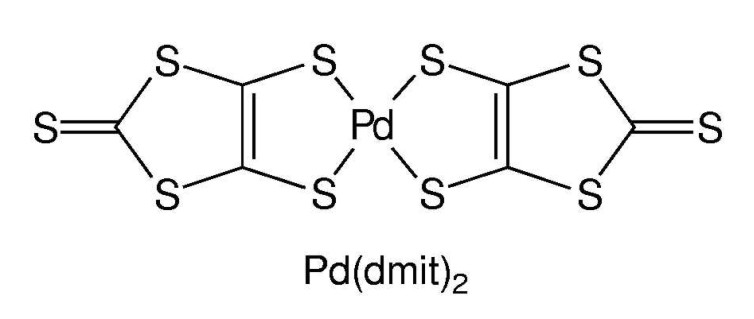
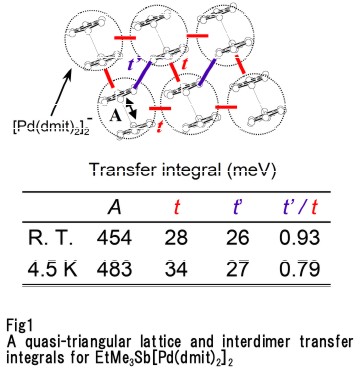
↑Top
(2)High pressure electrical properties of molecular conductor β'-Me4P[Pd(dmit)2]2 by using a Diamond Anvil Cell Cui, N. Tajima, Kato
Recently, novel electronic properties were discovered in a Mott-insulator system Pd(dmit)2 salts. In this system, physical properties can be easily effected by selection of the counter cation and external pressure. Under high pressure, most Pd salts show a superconducting transition. Although the Me4P salt has the widest band width in this system, it remains non-metallic at the lowest temperature. The previous high pressure experiments for the Me4P salt were performed by a cubic anvil cell. Up to 8 GPa, however, the non-metallic behavior could not be suppressed completely. Here we measured resistivity of the Me4P salt up to 20.2 GPa by using a diamond anvil cell. We found that the hydrostatic condition can be maintained as in the cubic anvil cell, and this salt turned to a complete metal under 10 GPa.
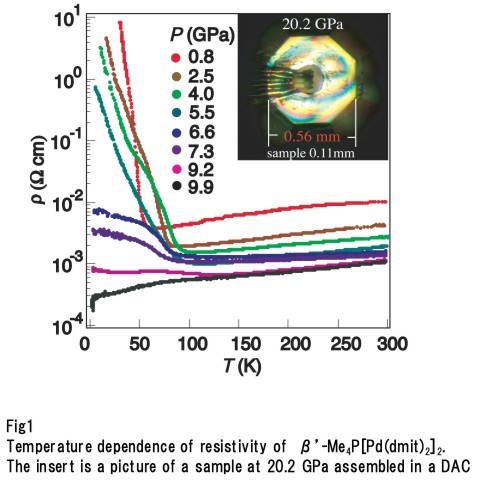
↑Top
2.Field effect measurement of molecular conductors on silicon substrate and organic Mott-FET H. M Yamamoto, Kawasugi, Ueno, Tajima, Kato; Fukunaga
Molecular conductors (organic charge transfer salts) provide various Mott-type semiconductors whose insulating phase is directly connected to a superconducting phase in their phase diagrams. We have fabricated FET structure with a thin-layer single crystal of κ-(BEDT-TTF)Cu[N(CN)2]Br laminated on a SiO2/Si substrate in order to study whether a Mott-transition FET is possible with this material. At low temperatures, the device showed a clear n-type FET behavior as shown in Fig. 1. The device mobility of the best sample measured by four-probe method reached 94 cm2/Vs. To understand the mechanism of this device, the Hall coefficient was measured and the carrier concentration was determined. Despite the n-type behavior of this device, the carrier under positive gate voltage was a hole and its number was almost 100 % of the 1st Brillouin zone (Fig. 2). This abnormal Hall effect can be interpreted on the basis of the band filling-controlled Mott-transition in this organic FET. (BEDT-TTF = bis(ethylenedithio)tetrathiafulvalene, FET = Field Effect Transistor)
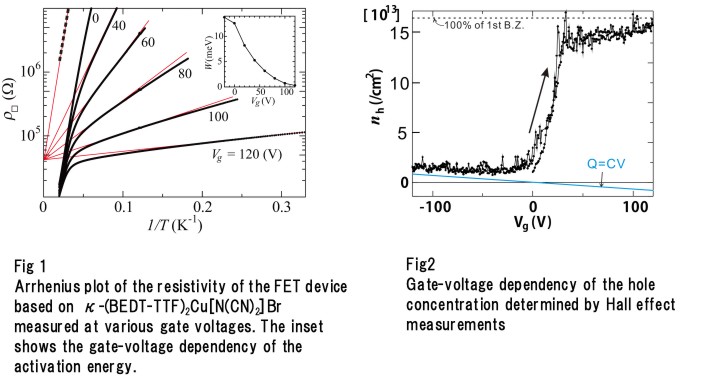
↑Top
3. Massless Dirac Fermions in Organic ConductorsN. Tajima, Kato
In this work, we investigated inter-layer magnetoresistance of massless Dirac Fermions system α-(BEDT-TTF)2I3. The purpose is to clarify the nature of Dirac particles in this system. This system exhibits various types of electronic states when the magnetic field is applied along in-plane or out-of-plane.
(1) Inter-layer transverse magnetoresistance
We have investigated inter-layer transverse magnetoresistance in an organic massless Dirac Fermions system, α-(BEDT-TTF)2I3, under hydrostatic pressure. This material exhibits the first two-dimensional zero-gap state in a bulk crystal with a layered structure. We succeeded in detecting the zero-mode Landau level (n=0 Landau level) that is expected to appear at the contact points of Dirac cones in the magnetic field normal to the two-dimensional plane. The characteristic feature of zero-mode Landau carriers including the spin splitting and valley splitting are clearly seen in the interlayer magnetoresistance.
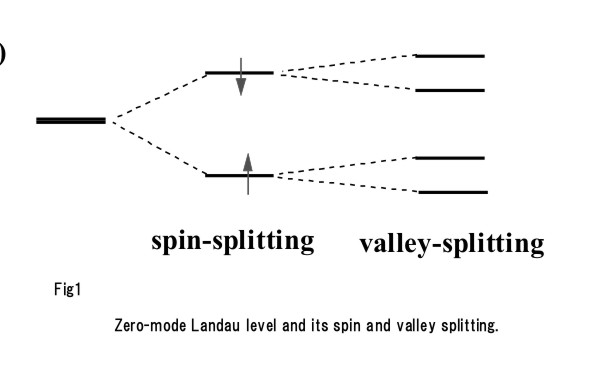
↑Top
(2) Inter-layer longitudinal magnetoresistanceWhen the magnetic field is applied in-plane in the zero-gap system, the Zeeman effect plays an important role to increase the density of state at the contact point. We succeeded in detecting the coherence peak in inter-layer longitudinal magnetoresistance.
↑Top
4.Photo-induced insulator to metal transition in BEDT-TTF saltsTakubo, N. Tajima, Kato
We have studied photo-induced phase transition by focusing charge order in BEDT-TTF salts. Previously, a photo-induced insulator-to-metal transition has been measured in α-(BEDT-TTF)2I3. In this year, we achieved photo-induced insulator-to-metal transition in (BEDT-TTF)3(ClO4)2, (BEDT-TTF)5Te2I6 and θ-(BEDT-TTF)2RbZn(CNS)4 (fast cooling). Anomalous photo current having two conducting state was measured by pulse laser irradiation under electric field in charge ordered state at 4 K (Fig.). The first conducting state stands up during pulse width (〜5 ns) and is comparable in magnitude to metal state at high temperature. This indicates that the charge order melted by photo excitation less than 5 ns and photo-induced insulator-to-metal transition occurred. The second conducting state is maintained after photo irradiation under electric field. The detailed mechanism is now under consideration.
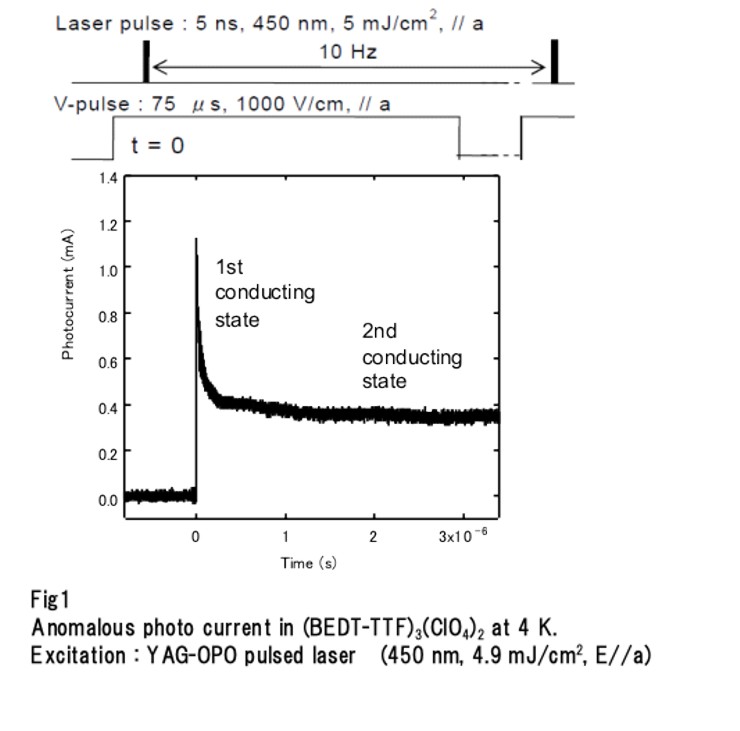
↑Top
5.Control of the electronic states in molecular conductors by use of dynamical external fields Oshima, Cui, Kato
The π-d molecular conductors show interesting physical phenomena, such as field-induced superconductivity or giant magneto-resistance, due to its non-negligible π-d interaction. The aim of this study is to control such interesting phenomena by flipping the local d spins or disturbing itinerant π-electrons by the use of oscillatory external fields. Here, we have focused on the λ-(BETS)2FexGa1-xCl4 system which shows field-induced superconductivity (FISC) at high magnetic fields, and have studied whether the FISC state can be controlled by ESR transitions, which correspond to the spin-flips of d-electrons. Simultaneous ESR and transport measurements were performed on λ-(BETS)2FexGa1-xCl4 (x=0.3, 0.5, 0.6), and we have observed a change in the resistance when the ESR transitions occur. This result indicates that the FISC phase is partially destroyed by the change of the spin states.
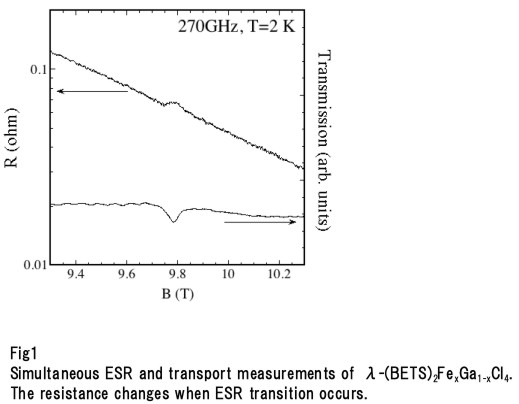
↑Top












